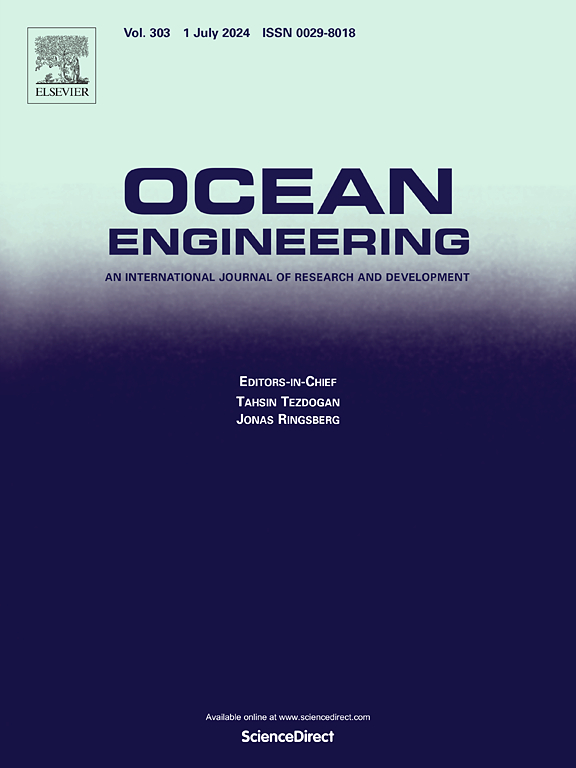Experimental investigation on hydrodynamic performance of a helmholtz resonator-based floating breakwater array
IF 5.5
2区 工程技术
Q1 ENGINEERING, CIVIL
引用次数: 0
Abstract
Addressing the limitations of traditional floating breakwaters in intermediate to long-period wave attenuation, this research experimentally investigated the hydrodynamic performance of a Helmholtz-type floating breakwater (FB) array. Bloch band theory was employed to predict resonant bands. The mechanism of Helmholtz resonance is explained. The influence of geometrical design parameters is also considered. It is found that Helmholtz resonance, unlike Bragg resonance, can occur in a single structure at a lower frequency, making it suitable for attenuating long waves. In addition, the band gaps derived from Bloch Band theory match well with the experimental results, accurately predicting the frequency ranges of Helmholtz resonance. When Helmholtz resonance is activated, the radiated waves produced inside the FB cavity interact with the incoming waves, leading to the dissipation of wave energy. The maximum dissipation coefficient is observed within the frequency range corresponding to Helmholtz resonance. Meanwhile, as the opening width decreases and the draft increases, the Helmholtz resonant frequency shifts toward lower frequencies, and the resonant intensity weakens. Increasing the number of models in the array enhances the resonant strength and improves wave attenuation performance, although the rate of improvement gradually diminishes. Moreover, combining models with the different opening widths and optimizing their arrangement sequence (i.e., placing models with larger openings at the front) can broaden the resonant frequency band and enhance the overall wave attenuation performance.
基于亥姆霍兹谐振器的浮式防波堤阵列水动力性能实验研究
针对传统浮式防波堤在中长周期波浪衰减方面的局限性,对亥姆霍兹型浮式防波堤(FB)阵列的水动力性能进行了实验研究。用布洛赫带理论预测共振带。解释了亥姆霍兹共振的机理。还考虑了几何设计参数的影响。与布拉格共振不同,亥姆霍兹共振可以在较低的频率下发生在单个结构中,使其适合于对长波的衰减。此外,布洛赫带理论得到的带隙与实验结果吻合较好,能准确预测亥姆霍兹共振的频率范围。当亥姆霍兹共振被激活时,FB腔内产生的辐射波与入射波相互作用,导致波能耗散。在亥姆霍兹共振对应的频率范围内,观察到最大的耗散系数。同时,随着开口宽度的减小和吃水的增加,亥姆霍兹谐振频率向低频偏移,谐振强度减弱。增加阵列中模型的数量可以增强谐振强度,改善波衰减性能,但改善的速率逐渐减小。此外,将不同开孔宽度的模型组合并优化其排列顺序(即将开孔较大的模型放在前面)可以拓宽谐振频带,提高整体的波衰减性能。
本文章由计算机程序翻译,如有差异,请以英文原文为准。
求助全文
约1分钟内获得全文
求助全文
来源期刊

Ocean Engineering
工程技术-工程:大洋
CiteScore
7.30
自引率
34.00%
发文量
2379
审稿时长
8.1 months
期刊介绍:
Ocean Engineering provides a medium for the publication of original research and development work in the field of ocean engineering. Ocean Engineering seeks papers in the following topics.
 求助内容:
求助内容: 应助结果提醒方式:
应助结果提醒方式:


